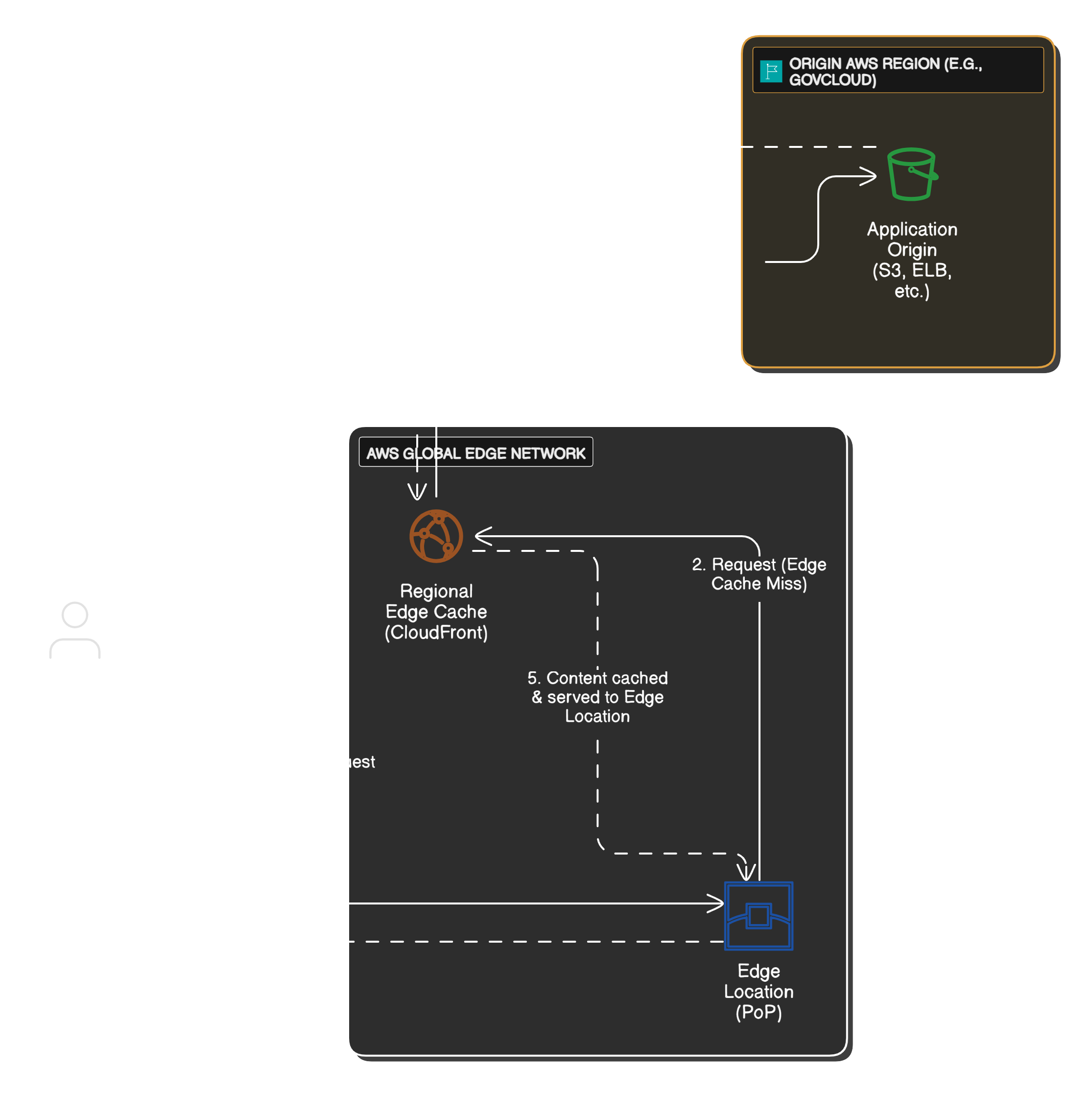AWS CloudFront Edge Network Architecture
This architecture demonstrates how AWS CloudFront's globally distributed network of Edge Locations and Regional Edge Caches work together to accelerate content delivery for Government applications. By strategically caching content closer to end-users, this multi-tiered system significantly reduces latency, offloads traffic from the origin, and enhances application resilience and security.
CloudFront Edge Network Diagram
The diagram below illustrates the complete content delivery flow, from the end-user request to the origin server hosted in an AWS GovCloud region, detailing the hierarchical caching process.

Architecture Components
The architecture is built on a hierarchical caching system designed to serve content from the closest possible location to the user, minimizing round-trip time.
-
Application Origin (AWS GovCloud Region):
- This is the authoritative source for all application content and data. It is securely hosted within an AWS GovCloud (US) Region to meet specific regulatory and compliance requirements for U.S. government agencies.
- Origins can be an Amazon S3 bucket for static assets, an Elastic Load Balancer (ELB) fronting EC2 instances for dynamic content, or other AWS services.
-
AWS Global Edge Network:
- A vast, worldwide network of data centers that CloudFront uses to deliver content with low latency and high transfer speeds. This network consists of two main tiers of caching locations.
- Edge Locations (Points of Presence - PoPs): These are the most numerous locations, globally dispersed to be as close as possible to end-users. They cache copies of content and are the first point of contact for user requests, terminating TLS/SSL connections to reduce handshake latency.
- Regional Edge Caches (RECs): Larger, mid-tier caching layers situated between the Edge Locations and the Application Origin. RECs have a larger cache-width than PoPs, allowing content to be retained for longer. This helps to consolidate multiple user requests for the same content and reduces the number of direct requests to the origin, a practice known as "origin offloading."
Detailed Traffic Flow Process
The content delivery process follows a logical sequence to optimize for speed and efficiency. The diagram illustrates a "cache-miss" scenario, where the content is not yet available at the edge.
Cache-Miss Scenario (Initial Request)
This flow corresponds directly to the numbered steps in the diagram:
- HTTPS Request: An end-user makes a request for content (e.g., a web page or an image). DNS routes the request to the nearest CloudFront Edge Location (PoP).
- Edge Cache Miss: The Edge Location checks its local cache. If the content is not found (a "cache miss"), it forwards the request to its parent Regional Edge Cache (REC).
- Regional Cache Miss: The REC checks its larger cache. If the content is also not found there, the REC forwards the request to the Application Origin in the AWS GovCloud region.
- Content Served from Origin: The Application Origin processes the request and sends the content back to the REC.
- Content Propagation to Edge: The REC caches the received content and forwards it to the originating Edge Location.
- Content Served to User: The Edge Location caches the content and delivers it to the end-user. This initial request experiences higher latency, but populates the caches for future requests.
Cache-Hit Scenario (Subsequent Requests)
- Edge Cache Hit: When another user in the same geographic area requests the same content, the Edge Location finds it in its local cache and serves it directly. This is the fastest possible response, providing the lowest latency.
- Regional Cache Hit: If the content has been flushed from the Edge Location's cache but is still in the REC, the request is served from the REC. This is still significantly faster than going all the way back to the origin.
Key Benefits for Government Applications
This multi-tier caching architecture provides several critical advantages for government workloads:
- Reduced Latency: By serving content from an Edge Location geographically close to the user, the architecture dramatically reduces round-trip time, leading to faster load times and a more responsive application experience.
- Enhanced Security: CloudFront integrates seamlessly with AWS Shield Standard (at no extra cost) for DDoS mitigation and AWS Web Application Firewall (WAF) to protect against common web exploits. All data in transit is secured with HTTPS.
- Improved Resilience and Availability: Caching content across the globe reduces the load on the origin infrastructure. This "origin offload" protects backend services from traffic spikes and can even allow content to remain available if the origin temporarily becomes unreachable.
- Cost Optimization: Serving requests from the cache significantly reduces Data Transfer Out (DTO) charges from the origin region (e.g., AWS GovCloud), which is a major factor in optimizing cloud costs.
- Scalability and Performance: The AWS Global Edge Network is built to handle massive, unpredictable traffic spikes, ensuring consistent performance for government applications during high-demand events without requiring manual scaling of the origin.